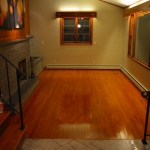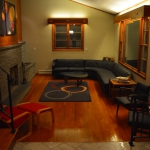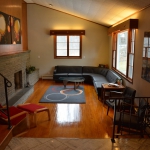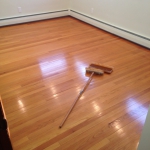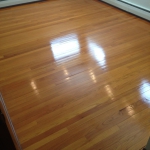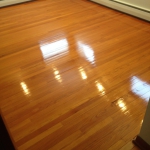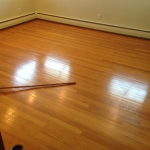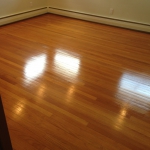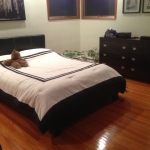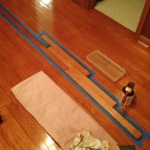One day shortly after moving into the house, my father in law was over and we got to discussing the fact that I was having a hard time matching the color on the floor with stain for a few spots that needed some touching up. He pointed out that given the age of the floors, they may very well be finished with amber shellac instead. I did some quick research and picked up some from the store. I tried it out and it turns out he was exactly right.
What is shellac, you may ask? Well, shellac is a natural resin that has been used for a very long time (centuries, I believe) as a protectant for various items, not just wood. It is produced by insects and harvested as flakes. To use it, the flakes are dissolved in denatured alcohol so it can be spread evenly on a surface. You can order the flakes and make it yourself, but it is usually just as easy to purchase it pre-mixed locally, unless your needs are very specific (like you need a unique color)
Up until the 1950s with the advent of polyurethane, shellac was one of the most popular wood finishes. It is all natural, goes on quickly, and dries very hard and durable. Polyurethane is technically more durable, but is has a somewhat “plastic” look (because it is a plastic coating.) Also, if you have worked with polyurethane you know the fumes are terrible and you have to wait a very long time (up to 24 hours) between coats.
Of course, this meant that I had to shellac all the wood floors in the house.
Because I’m using shellac, this isn’t quite as big of a project as you may think. Unlike polyurethane, when you have a shellac coating, you can simply add another coating on top of the existing – you do not have to strip, re-stain and then put down a new top coat. Shellac, including the stuff on your floor already, can be re-dissolved with denatured alcohol. So when you add a fresh coat, what is actually happening is it slightly melts the original coat, blends them together, and they harden as one single topcoat.
Other cool things about shellac:
1. You can thin shellac as needed with more denatured alcohol. When you thin it, it makes it more runny and easier to apply evenly to a horizontal surface like a floor without getting “lap marks” (lap marks are the places where you did two strokes side by side and you can see where they overlapped.)
2. Shellac is able to be re-coated in as little as one hour.
3. Shellac is all natural – denatured alcohol has a low odor and unlike polyurethane, you do not have to clear the room for a day while applying it. The alcohol (denatured alcohol is basically distilled spirits with a chemical to make it taste terrible) evaporates away, leaving nothing but the shellac resin when dried.
4. When you have a scratch, you can brush a little bit of denatured alcohol over the spot and it will melt the existing shellac and allow you to “patch” the scratch relatively easily.
It took about two weeks to do all the floors in the house. I went through first and ensured that any nail holes leftover from the carpet tack strips were filled, then I just tackled one room at a time. To do a project like a floor, a lambswool applicator is a must – they are cheap and allow you to do the entire floor in minutes.
Here’s the before and afters for various rooms:




